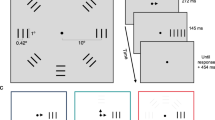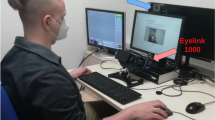Abstract
Visual evoked potentials can be elicited by a variety of visual stimuli, including pattern-onset and motion-onset. It may be desirable to combine pattern-onset with motion-onset stimuli, for example, to make a direct comparison between optokinetic nystagmus and visual evoked potential acuity thresholds. Both procedures employ grating stimuli; however, the gratings must be moving to produce optokinetic nystagmus. We compared pattern-onset visual evoked potentials with both a static and a moving pattern to investigate the effect of motion on the pattern-onset visual evoked potential waveform. Visual evoked potential recordings were made from 10 adults (aged 20–37 years) and 10 children (aged 5–7 years) with the active electrode at Oz. Stimuli consisted of onset of high-contrast vertical bars of three sizes (12′, 30′ and 60′) both with and without motion (3 cycles/s). In a subgroup of subjects, visual evoked potentials were recorded to motion onset of constantly present gratings. Motion of the pattern had no significant effect on any of the latency components of the visual evoked potential waveform in adults or children. The amplitude of the C2–C3 component was significantly increased (p < 0.001) in adults. The motion appears to add a late negative component to the visual evoked potential similar to that produced by the motion-only stimulus. The latency of the early components of the pattern-onset visual evoked potential was unaffected by the presence of motion. Therefore, pattern-onset visual evoked potentials with moving gratings could be used to estimate visual acuity, and direct comparisons could be made between visual evoked potential and optokinetic nystagmus acuity thresholds with the use of the same stimulus parameters.
Similar content being viewed by others
Abbreviations
- ANOVA:
-
analysis of variance
- OKN:
-
optokinetic nystagmus
- ON-M:
-
onset with motion
- ON:
-
onset without motion
References
Marg E, Freeman DN, Peltzman P, Goldstein PJ. Visual acuity developmen in human infants: evoked potential measurements. Invest Ophthalmol 1876; 15: 150–3.
Odom JV, Green M. Visually evoked potentials (VEP) acuity: testability in a clinical pediatric population. Acta Ophthalmol 1984; 62: 993–8.
Mohn G, van Hof-van Duin J. Behavioural and electrophysiological measures of visual functions in children with neurological disorders. Behav Brain Res 1983; 10: 177–87.
Saunders KJ, McCulloch DL. Kerr AM. Visual function in Retts syndrome. Dev Med Child Neurol 1995; 37: 496–504.
Mackie RT, McCulloch DL, Saunders KJ, Ballantyne J, Day RE, Bradnam MS, Dutton GN. Comparison of visual assessment tests in multiply handicapped children. Eye 1995; 9: 136–41.
Spekrijse H, Maturation of contrast EPs and development of visual resolution. Arch Ital Biol 1978; 116: 368–69.
Sokol S. Measurement of infant visual acuity from pattern reversal evoked potentials. Vision Res 1978; 18: 33–9.
Reinecke RD, Cogan DG. Standardization of objective visual acuity measurements: optokinetic nystagmus vs Snellen acuity. AMA Arch Ophthalmol 1958; 60: 418–21.
Lewis TL, Maurer D, Brent HP. The development of visual resolution in infants and toddlers tested monocularly with OKN. Clin Vision Sci 1990; 5: 231–41.
Jasper HH. Report of the committee on methods of clinical examination in electroencephalography. Electroencephalogr Clin Neurophysiol 1967; 10: 370–5.
Bradnam MS, Evans AL. Montgomery DMI, Keating D, Damato BE, Cluckie A, Allan D. A personal computer-based visual evoked potential stimulus and recording system. Doc Ophthalmol 1994; 86: 81–93.
Spekrijse H. Comparison of acuity test and pattern evoked potential criteria: two mechanisms underly acuity maturation in man. Behav Brain Res 1983; 12: 107–17.
De Vries-Khoe M, Spekreijse H. Maturation of luminance and pattern EPs in man. Doc Ophthalmol Proc Ser 1982; 31: 461–75.
Jones R, Keck MJ. Visual evoked response as a function of grating spatial frequency. Invest Ophthalmol Vis Sci 1978; 17: 652–9.
Kubova A, Kuba M, Hubacke J, Vit F. Properties of visual evoked potentials to onset of movement on a television screen. Doc Ophthalmol 1990; 75: 67–72.
Carl JR, Gellman RS. Human smooth pursuit: stimulus-dependent responses. J Neurophysiol 1987; 57: 1446–63.
Yokoyama M, Matsunaga I, Yonekura Y, Shinzato K. The visual evoked response to moving pattern In: Proceedings of the 16th ISCEV Symposium, 1979: 207–14.
Göpfert E, Müller R, Markwardt F, Schlykowa L. Visuell evozierte Potentiale bei Musterbewegung. Z EEG-EMG 1983; 14: 47–51.
Kuba M, Kubova Z. Visual evoked potentials specific for motion onset. Doc Ophthalmol 1992; 80: 83–9.
Kubova Z, Juba M, Spekreijse H, Blakemore C. Contrast dependence of motion-onset and pattern-reversal evoked potentials. Vision Res 1995; 35: 197–205.
Dagnelie G, DeVries MJ, Maier J, Spekreijse H. Pattern reversal stimuli: motion or contrast? Doc Ophthalmol 1986; 61: 343–9.
DeVries M, Van Dijk B, Spekreijse H. Motion onset-offset VEPs in children. Electroencephalogr Clin Neurophysiol 1989; 74: 81–7.
Bach M, Ullrich D. Motion adaptation governs the shape of motion-evoked cortical potentials. Vision Res 1994; 34: 1541–7.
Author information
Authors and Affiliations
Rights and permissions
About this article
Cite this article
Mackie, R.T., Mcculloch, D.L., Bradnam, M.S. et al. The effect of motion on pattern-onset visual evoked potentials in adults and children. Doc Ophthalmol 91, 371–380 (1995). https://doi.org/10.1007/BF01214655
Accepted:
Issue Date:
DOI: https://doi.org/10.1007/BF01214655




